This Brontë timeline highlights key events in the lives of sisters Charlotte, Emily, and Anne, their brother Branwell, and their parents, Patrick and Maria, along with their aunt, Elizabeth Branwell who cared for them after their mother's death.
Key moments in their lives and literary careers are captured in this Brontë chronology, showcasing how these experiences shaped their remarkable contributions to literature.
Much credit goes to the now-defunct Haworth-Village website, where much of this timeline was first published.
02/12/1776
Elizabeth Branwell was born at Penzance in Cornwall, elder sister of Maria Branwell. She brought up the
Brontë children after their mother, Maria Branwell (Brontë), died.
17/03/1777
Patrick Brontë was born at Emdale, Drumballyroney, County Down, Ireland.
15/04/1783
Maria Branwell was born at Penzance, Cornwall.
01/10/1802
Patrick Brontë, aged 25, registered as a student at St John's College, Cambridge.
03/10/1802
Patrick Brontë, a student at St John's College, Cambridge, changed the spelling of his name from Brunty to Brontë.
23/04/1806
Patrick Brontë was awarded a Bachelor of Arts degree.
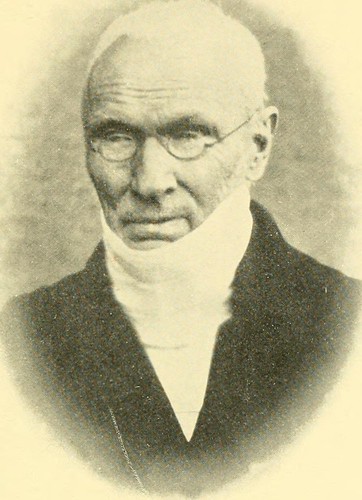
01/01/1809
Patrick Brontë conducted his last parish duty at St Mary Magdalene Church of Wethersfield in Essex, performing a burial. He had taken the post of curate in the autumn of 1806.
05/12/1809
Patrick Brontë began his curacy at Dewsbury.
29/09/1810
Elizabeth Gaskell, who wrote 'The Life of Charlotte Brontë', was born.
29/12/1812
Patrick Brontë and Maria Branwell were married at Guiseley Church.
23/04/1814
Maria Brontë, the first child of the Brontë family, was baptised at Hartshead.
08/02/1815
Elizabeth Brontë, second child of the Brontë family, was born at Hartshead.

26/08/1815
Elizabeth Brontë, the second child of the Brontë family, was baptised at Thornton.
21/04/1816
Charlotte Brontë, the third child of the Brontë family, was born at Thornton.
29/06/1816
Charlotte Brontë, the third child of the Brontë family, was baptised at Thornton.
26/02/1817
Mary Taylor, a close friend of Charlotte Brontë, was born.
26/06/1817
Patrick Branwell Brontë, the fourth child of the Brontë family, was born at Thornton.
30/07/1818
Emily Jane Brontë, the fifth child of the Brontë family, was born at Thornton.
20/08/1818
Emily Jane Brontë, the fifth child of the Brontë family, was baptised.
06/01/1819
Arthur Bell Nicholls was born in Killhead, County Antrim, Ireland. He would later become Charlotte Brontë’s husband.
19/11/1819
The resignation of the Rev. Samuel Redhead from the Perpetual Curacy of Haworth was officially recorded by the Bradford Parish Clerk.
Redhead had the shortest tenure, lasting just three weeks due to local outrage that he was appointed without consulting the Trustees. Elizabeth Gaskell wrote:
"A man rode into the church upon an ass, with his face turned towards the tail, and as many old hats piled on his head, as he could possibly carry. He began urging his beast round the aisles, and the screams, and cries, and laughter of the congregation entirely drowned all sound of Mr. Redhead's voice; and, I believe, he was obliged to desist."
17/01/1820
Anne Brontë, the sixth child of the Brontë family, was born at Thornton.
25/02/1820
Patrick Brontë was granted perpetual curacy of Haworth.
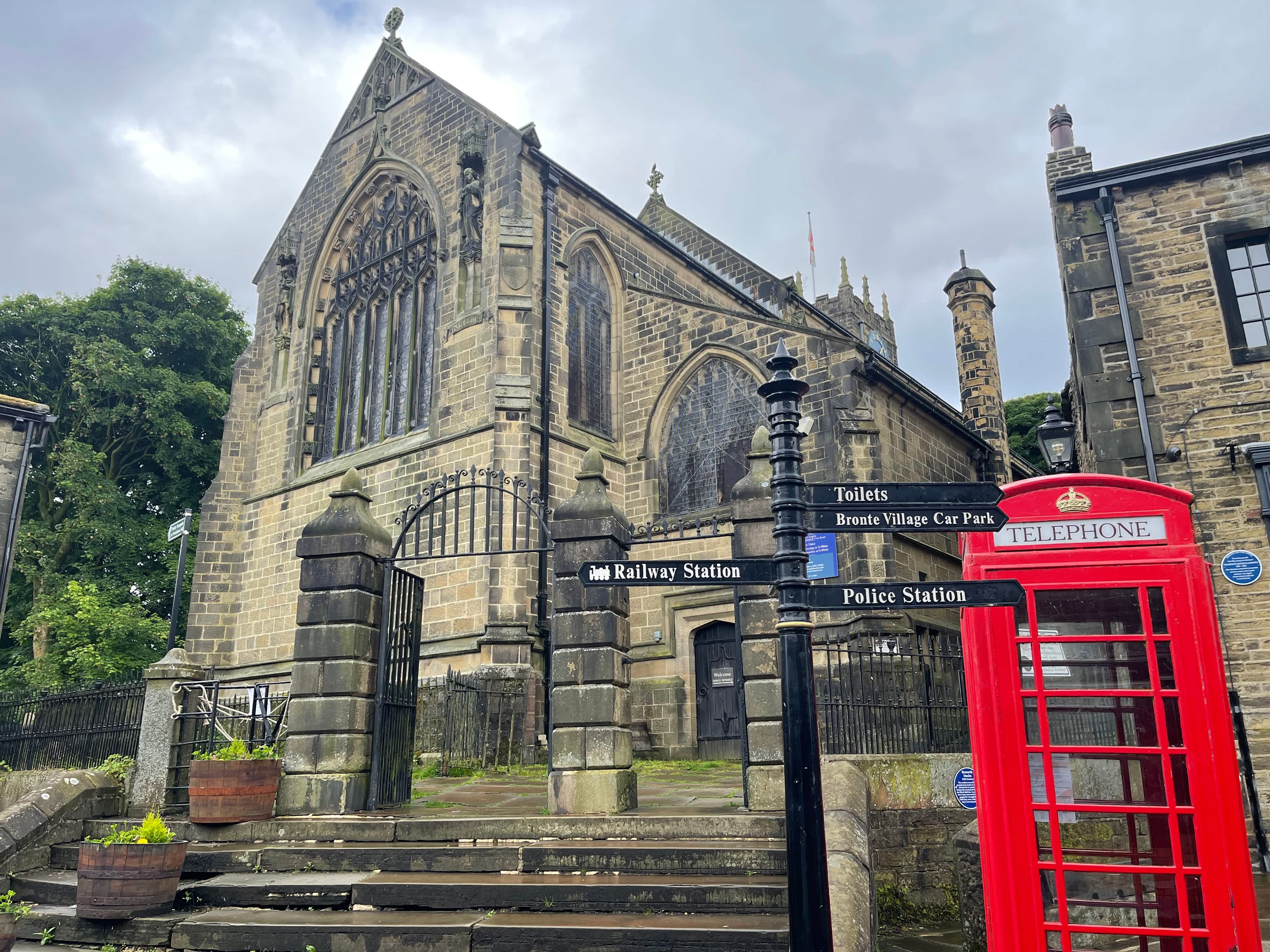
25/03/1820
Anne Brontë, the sixth child of the Brontë family, was baptised at Thornton.
20/04/1820
The Brontë family moved from Thornton to
Haworth Parsonage. The procession of seven carts and one covered wagon traveled up Main St (then known as Kirkgate), ending at Parsonage Lane (now Church St).
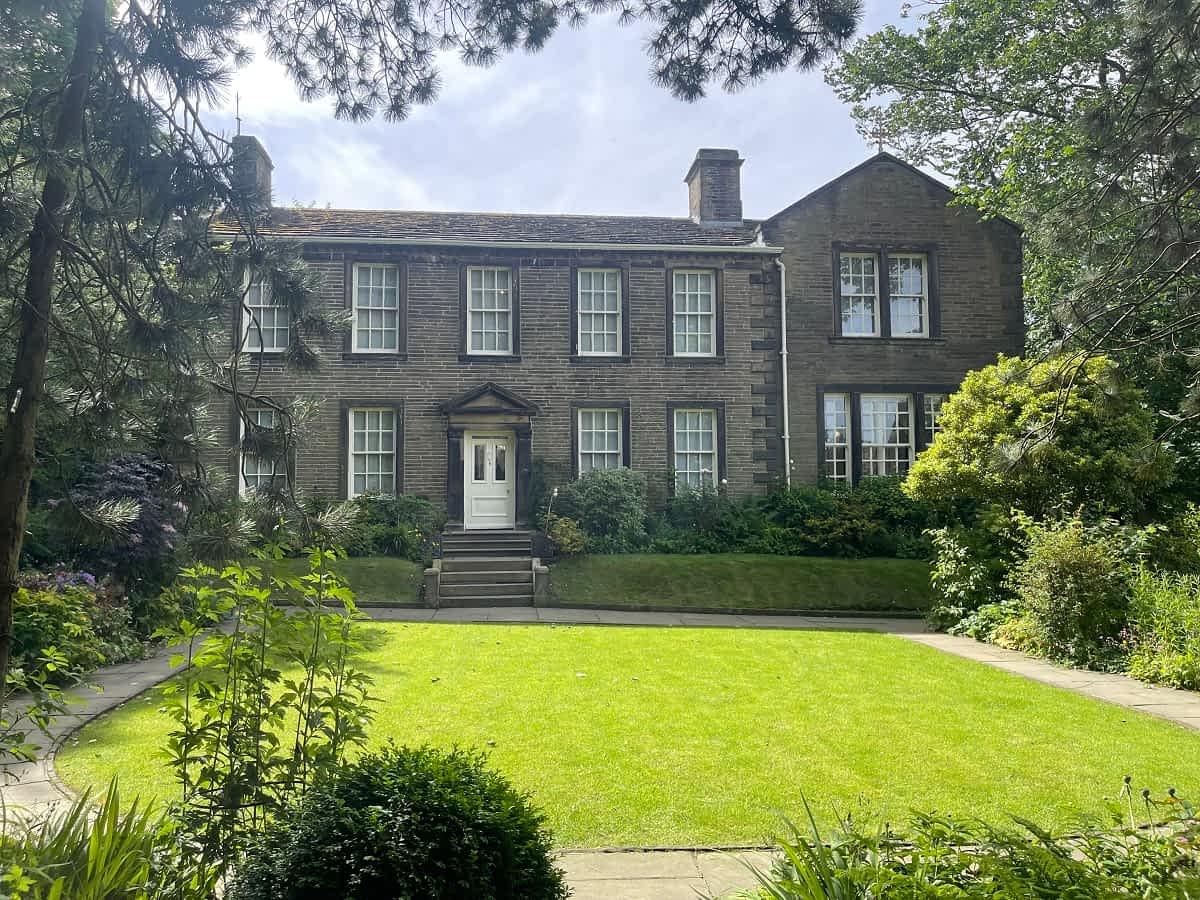
21/01/1821
Maria Brontë, wife of Patrick Brontë, was diagnosed with cancer.
15/09/1821
Maria Brontë, wife of Patrick Brontë, died at Haworth, aged 38.
22/09/1821
Maria Brontë, wife of Patrick Brontë, was buried in the family vault at Haworth Parish Church. She had died on 15 September, aged 38.
27/11/1821
Patrick Brontë wrote:
"My dear wife was taken dangerously ill on the 29th of January last; and in a little more than seven months afterwards she died. During every week and almost every day of this long tedious interval I expected her final removal. I was left quite alone, unless you suppose my six little children and the nurse and servants to have been company."
21/04/1823
Patrick Brontë wrote to Mary Burder's mother in Wethersfield, Essex, explaining the past 14 years of his life and inquiring about her family.
His wife, Maria, had died in 1821. Patrick, who had met Mary Burder when he was curate of St. Mary Magdalene Church in Essex from 1806-1809, was struggling to cope alone with his six young children.
21/07/1824
The eldest Brontë girls, Maria and Elizabeth, were sent to the Clergy Daughters' School at Cowan Bridge.
10/08/1824
Charlotte Brontë was sent to the Clergy Daughters' School at Cowan Bridge.
25/11/1824
Emily Brontë was sent to the Clergy Daughters' School at Cowan Bridge.
06/05/1825
Maria Brontë, the first child of the Brontë family, died at Haworth of consumption at age 12.
01/06/1825
The Brontë sisters left the Clergy Daughters' School at Cowan Bridge, where conditions were described as disgusting and filthy.
15/06/1825
Elizabeth Brontë died at Haworth, aged 10.
18/06/1825
Elizabeth Brontë, aged 10, was buried at Haworth.
25/07/1825
Timothy Feather was baptised by Patrick Brontë. He later became known as the last handloom weaver and lived all his life in Stanbury.
05/07/1826
Patrick Brontë returned from Leeds and gave a box of toy soldiers to Branwell.
22/04/1828
Martha Brown, who later became a servant to the Brontë household, was born.
12/03/1829
"I am in the Kitchen of the Parsonage house Haworth. Tabby the servant is washing up after breakfast and Anne my youngest sister is kneeling on a chair looking at some cakes which Tabby has been baking for us. Emily is in the parlour brushing it, papa and Branwell are gone to Keighley. Aunt is up stairs in her room and I am sitting by the table writing this in the kitchen."
— Charlotte Brontë, The History of the Year
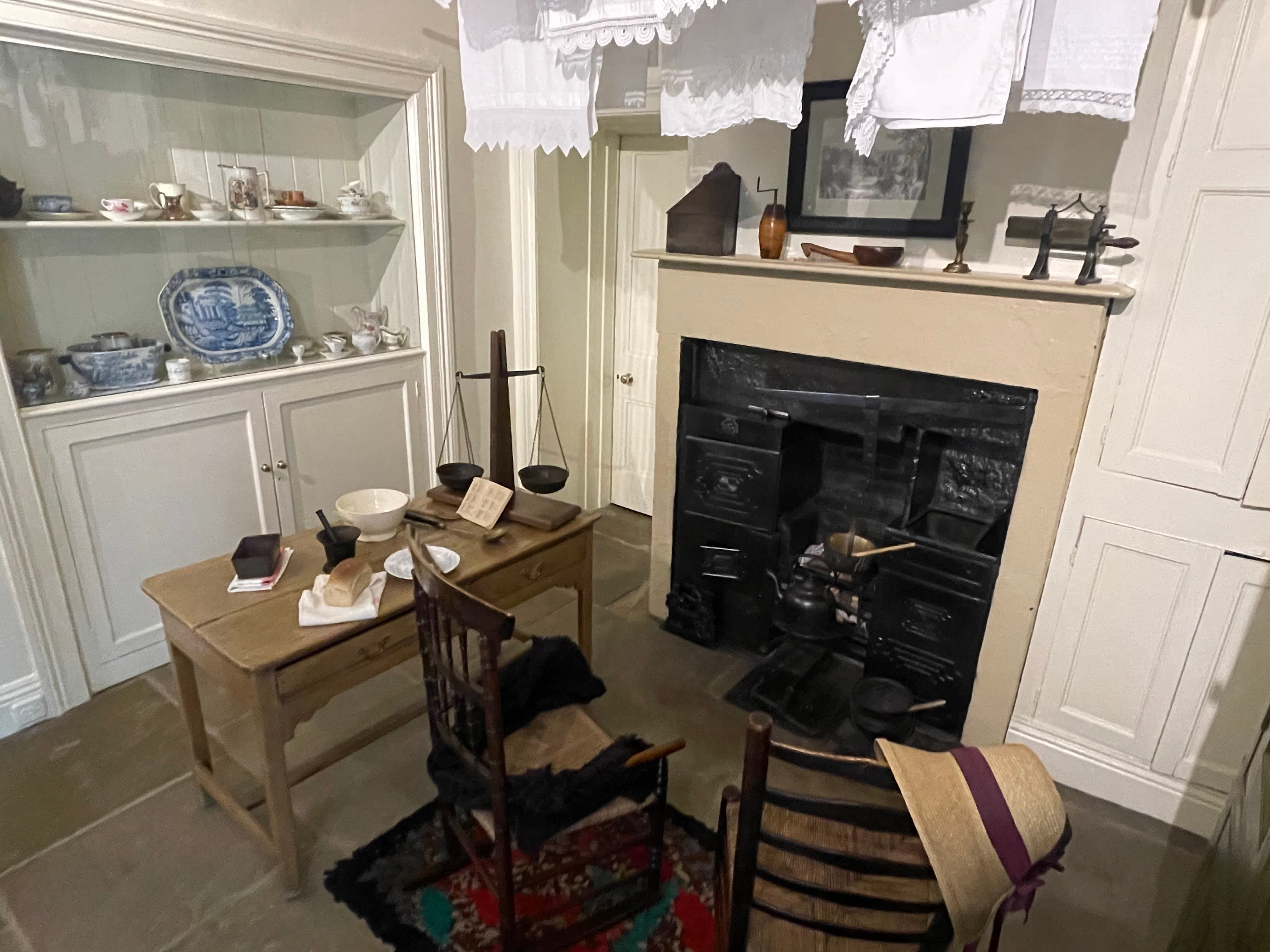
13/07/1830
A watercolour still life of wild roses was painted by Charlotte Brontë "from nature."
22/08/1830
Charlotte Brontë wrote her poem "Morning".
30/04/1833
Aunt Branwell, who raised the Brontë children, made her will. The money helped finance the early publications of Charlotte, Emily, and Anne.
24/11/1834
Emily Brontë wrote:
"I fed Rainbow, Diamond, Snowflake, Jasper pheasant alias this morning. Branwell went down to Mr. Driver's and brought news that Sir Robert Peel was going to be invited to stand for Leeds. Anne and I have been peeling apples for Charlotte to make an apple pudding... Taby said just now, 'Come Anne pillopatate...'"
29/07/1835
Charlotte Brontë went as a teacher to Miss Wooler's school at Roe Head. Emily accompanied her as a pupil.
01/02/1836
Branwell Brontë was proposed as a Freemason.
29/02/1836
Branwell Brontë became a full member of the Three Graces Lodge in Haworth.
22/02/1837
A meeting was held in the Sunday School rooms, chaired by Patrick Brontë, to repeal the Poor Law Amendment Act of 1834.
12/03/1837
Charlotte Brontë received a letter from Robert Southey, the Poet Laureate: "Literature cannot be the business of a woman's life: & it ought not to be."
07/08/1837
Emily Brontë wrote her poem "O God of Heaven! The dream of horror".
14/05/1838
Branwell Brontë wrote his poem "At dead of midnight drearily".
04/12/1838
Emily Brontë wrote the poem:
"A little while, a little while, The noisy crowd are barred away; And I can sing and I can smile A little while I've holiday!"
18/12/1838
Emily Brontë wrote her poem "The Bluebell".
12/01/1839
Emily Brontë wrote the poem "The night was dark yet winter breathed...."
26/03/1839
Charlotte Brontë wrote her poem "Life".
08/04/1839
Anne Brontë became governess for the Ingham family at Blake Hall, Mirfield.
12/07/1839
Emily Brontë wrote her poem "And now the house-dog stretched once more".
30/09/1839
Emily Brontë wrote the poem "The organ swells the trumpets sound".
14/11/1839
Emily Brontë wrote the poem "Well, some may hate, and some may scorn, And some may quite forget thy name...".
06/01/1840
Emily Brontë wrote the poem "Thy son is near meridian height, and my sun sinks in endless night...".
14/02/1840
William Weightman, Patrick Brontë's curate, sent Valentines to the three Brontë sisters—the first they had ever received.
31/08/1840
Branwell Brontë was appointed Assistant Clerk at Sowerby Bridge Railway Station near Halifax. His starting salary was £75 a year.
01/03/1841
Emily Brontë wrote her poem "Riches I hold in light esteem and Love I laugh to scorn...".
02/03/1841
Charlotte Brontë became a governess for the White family who lived at Upperwood House, Rawdon, near Bradford.
01/04/1841
Branwell Brontë was employed as Clerk in Charge of Luddenden Foot station near Hebden Bridge. While there he was known to frequent the Lord Nelson Tavern.
16/07/1841
Emily Brontë wrote her poem "Aye, there it is! It wakes tonight".
12/12/1841
Charlotte Brontë wrote her poem "Passion".
08/02/1842
Charlotte and Emily Brontë began their journey to Brussels to stay at the Pensionnat Heger, a finishing school run by the Heger family. Patrick Brontë travelled with them on the journey.
31/03/1842
Branwell Brontë was dismissed from his post as Clerk in Charge of Luddenden Foot station near Hebden Bridge. There was a deficit in the station accounts attributed to Branwell Brontë's incompetence rather than theft.
14/08/1842
William Weightman, Patrick Brontë's curate, performed his last duty at Haworth. He had been visiting the sick and was taken ill with cholera; he died on 6th September 1842.
06/09/1842
William Weightman aged 26, who was Patrick Brontë's curate, died of cholera, the disease was prevalent in Haworth at the time.
"He was three years curate of Haworth and by the Congregation and Parishioners in general was greatly respected for his orthodox principles, active zeal, moral habits, learning, mildness and affability. His useful labours will long be gratefully remembered by the members of the Congregation and Sunday School Teachers and Scholars."
10/09/1842
William Weightman, Patrick Brontë's curate, was buried. He had died of cholera on 6th September, the disease was prevalent in Haworth at the time.
02/10/1842
A memorial service was given by Patrick Brontë in memory of William Weightman, who had died of cholera on 6th September. Patrick Brontë had loved him as a son.
29/10/1842
Elizabeth Branwell, aunt to the Brontë children who brought them up, died aged 66.
03/11/1842
Elizabeth Branwell, aunt to the Brontë children who brought them up, was buried at Haworth. She had died aged 66 on 29th October.
10/11/1842
Anne Brontë wrote her poem "To Cowper".
26/12/1842
Branwell Brontë attended his last meeting as a Mason of the Three Graces Lodge in Haworth.
30/03/1843
Branwell Brontë wrote his poem "Thorpe Green".
04/08/1843
Charlotte Brontë's tutor M. Heger presented her with a wood fragment from Napoleon's coffin.
04/10/1843
Patrick Brontë wrote to the Church trustees about the rumour in Haworth village regarding the lotion he was using for his weak eyesight. Gossip had circulated that the smell was similar to alcohol.
31/10/1843
Anne Brontë wrote her poem "The Captive Dove".
29/12/1843
Charlotte Brontë received a Diploma from the Pensionnat at Brussels.
01/01/1844
Charlotte Brontë left the Pensionnat at Brussels for home. While studying there she had received a Diploma.
03/01/1844
Charlotte Brontë arrived back home at Haworth Parsonage; she had been studying at the Heger's Pensionnat at Brussels.
11/03/1844
Emily Brontë wrote her poem "The Wanderer from the Fold".
01/05/1844
Emily Brontë wrote a poem "The linnet in the rocky dells, The moor-lark in the air...".
18/01/1845
Anne and Branwell Brontë returned to their employment as tutors for the Robinson family at Thorp Green.
03/02/1845
Emily Brontë wrote her poem "The Philosopher".
03/03/1845
Emily Brontë wrote her poem "Remembrance".
10/04/1845
Emily Brontë wrote her poem "Death".
14/04/1845
Emily Brontë wrote the poem Stars: "....All through the night, your glorious eyes were gazing down in mine,...".
18/05/1845
The Reverend Arthur Bell Nicholls aged 26 was appointed Curate at Haworth with a salary of £100 per annum. He married Charlotte Brontë in 1854.
20/05/1845
Anne Brontë wrote her poem "If this be all".
18/06/1845
Branwell Brontë returned to his employment as tutor with the Robinson family at Thorp Green. While there he had an affair with Mrs Robinson.
17/07/1845
Branwell Brontë was dismissed from his post as tutor for the Robinson family at Thorp Green. It had been discovered that while there, he had an affair with Mrs Robinson.
02/01/1846
Emily Brontë wrote her poem "No coward soul is mine, No trembler in the world's storm-troubled sphere...".
06/02/1846
Charlotte Brontë sent a manuscript of poems to Messrs. Aylott and Jones publishers. They used the pseudonym of Acton, Currer and Ellis Bell.
06/04/1846
Charlotte Brontë wrote to publisher Aylott & Jones: "C.E & A Bell are now preparing for the Press a work of fiction - consisting of three distinct and unconnected tales which may be published together as a work of 3 vols. of ordinary novel-size, or separately as single vols - as shall be deemed most advisable."
09/04/1846
Branwell Brontë visited the Halifax Guardian and placed an advert for a post that would take him abroad.
07/05/1846
First printed copies of the Book of "Poems" by Charlotte, Emily and Anne Brontë arrived at the Parsonage. They had used the pseudonym of Acton, Currer and Ellis Bell.
26/05/1846
Mrs Robinson's husband died; she had a relationship with Branwell Brontë, and news of the death gave Branwell hope of marriage.
04/07/1846
The published Brontë Poems using the pseudonym of Acton, Currer and Ellis Bell received favourable criticism. Only two copies were sold.
26/08/1846
Surgeons performed an operation on Patrick Brontë's cataracts at Manchester. The operation was successful, and after a month convalescing, he was able to read again.
14/09/1846
Emily Brontë wrote the poem “Why ask to know the date – the clime?”.
13/12/1846
Branwell Brontë, through heavy drinking, had incurred debts. Officers charged him to pay the debt off or go to prison. The Brontë family had to bail him out.
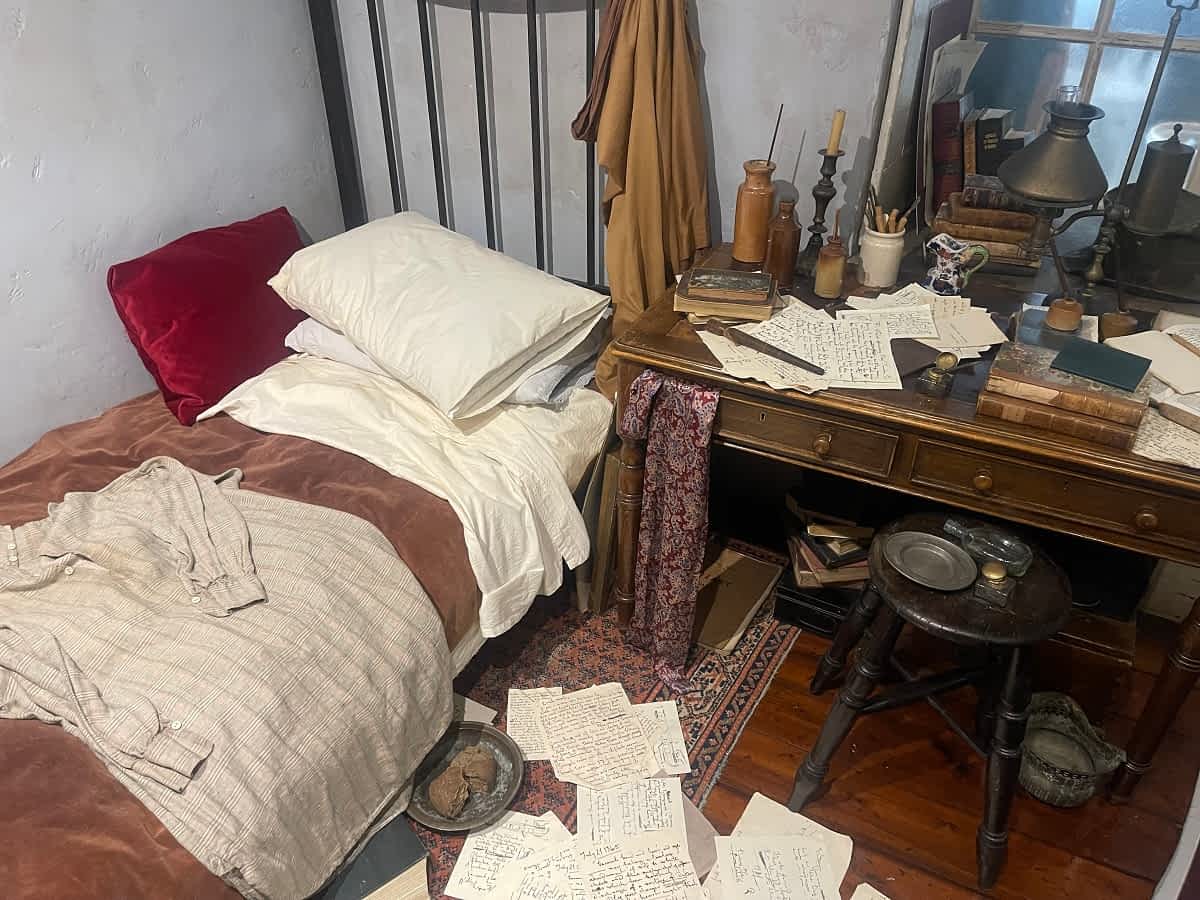
15/12/1846
Charlotte Brontë wrote: "I hope you are not frozen up; the cold here is dreadful. I do not remember such a series of North-Pole days. England might really have taken a slide up into the Arctic Zone; the sky looks like ice; the earth is frozen; the wind is as keen as a two-edged blade."
25/12/1846
Music I love--but never strain
Could kindle raptures so divine,
So grief assuage, so conquer pain,
And rouse this pensive heart of mine--
As that we hear on Christmas morn,
Upon the wintry breezes borne.....
Music On Christmas Morning - Poem by Anne Brontë, published in the 1846 collection Poems By Currer, Ellis and Acton Bell under Anne's nom de plume 'Acton Bell'.
04/07/1847
The manuscripts of Emily Brontë's Wuthering Heights and Anne's Agnes Grey were sent to the publishers; T.C. Newby. They were published in December 1847.
15/07/1847
Charlotte Brontë sent the manuscript of the "Professor" to the publisher Smith, Elder and Co. Cornhill. It was not published.
24/08/1847
Charlotte Brontë's manuscript of Jane Eyre was sent to the publisher Smith, Elder and Co. Cornhill.
16/10/1847
Charlotte Brontë's novel 'Jane Eyre' was published under the pseudonym Currer Bell.
19/10/1847
Charlotte Brontë received copies of her published novel 'Jane Eyre'.
10/12/1847
Charlotte Brontë received payment for her novel Jane Eyre, which was published on 16th October 1847.
14/12/1847
Emily and Anne received six published copies of their novels, Wuthering Heights and Agnes Grey, from their publishers.
08/07/1848
Charlotte and Anne Brontë visited London to meet their publisher and revealed their true identity. The Brontë sisters had been using the pseudonyms Acton, Currer, and Bell.
22/07/1848
Anne Brontë finished the preface to the second edition of her novel, The Tenant of Wildfell Hall.
28/09/1848
Branwell Brontë was buried in the family vault at Haworth Parish Church. He had died on 24th September, aged 31. The service was conducted by William Morgan.
16/11/1848
Emily Brontë's health was poor. Charlotte Brontë wrote of her sister having difficulty breathing and pains in her chest.
19/12/1848
Emily Brontë died at 2 o'clock in the afternoon. She was 30 years old.
22/12/1848
Emily Brontë was buried in the family vault at Haworth Parish Church. She had died on 19th December, aged 30.
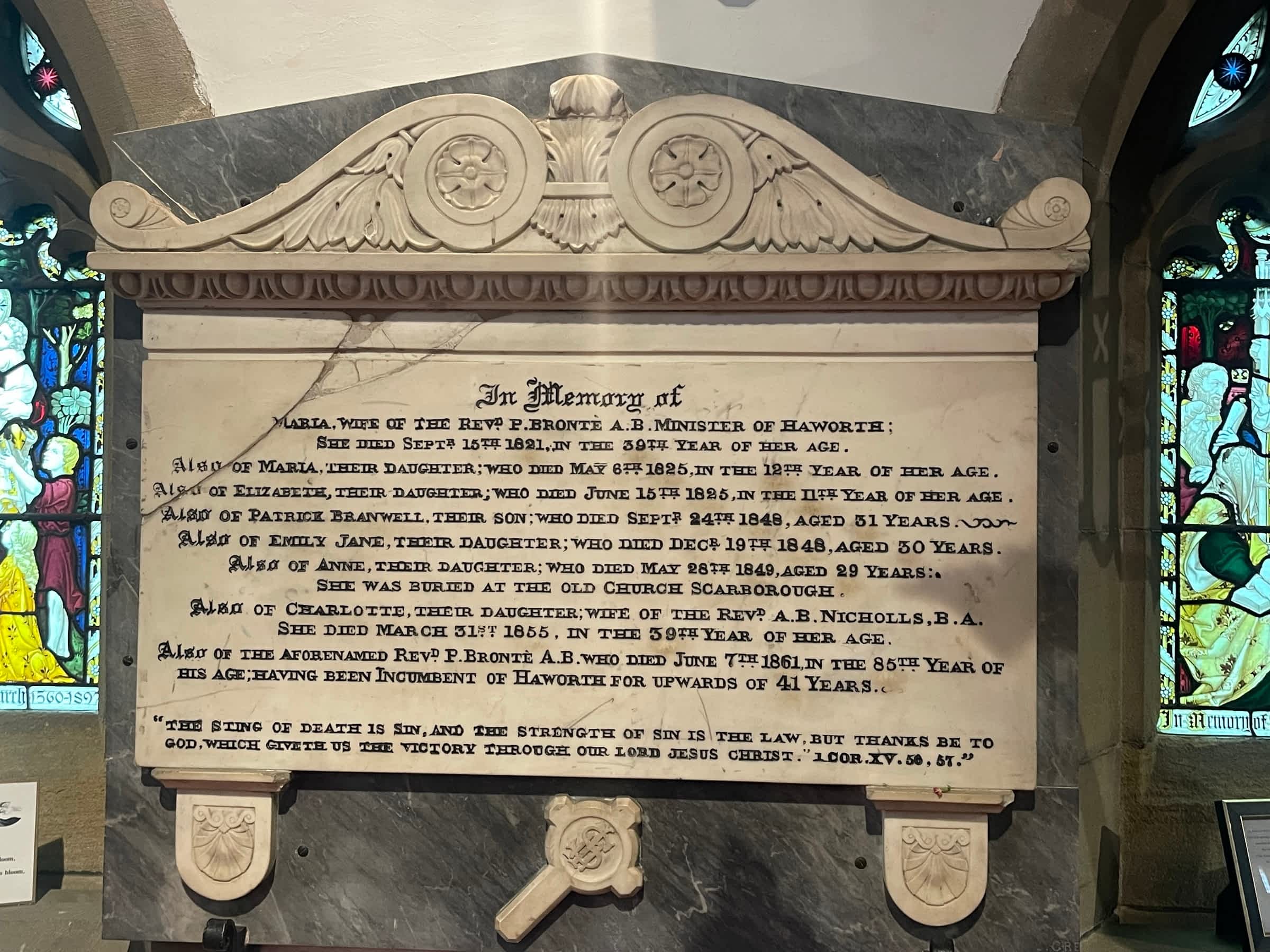
05/01/1849
Anne Brontë caught influenza; consumption was diagnosed in both lungs.
24/05/1849
Charlotte and Anne Brontë went to Scarborough with Ellen Nussey. Anne’s health was declining.
28/05/1849
Anne Brontë died at 2 o'clock in the afternoon, aged 29, at Scarborough.
30/05/1849
Anne Brontë was buried at St Mary's Churchyard, Castle Hill, Scarborough. She had died on 28th May, aged 29.
28/08/1849
The lack of fresh water in Haworth was a concern. Patrick Brontë had prepared a petition which was sent to the General Board of Health in London in an effort to improve sanitation.
29/08/1849
Charlotte Brontë completed her novel Shirley.
09/10/1849
Patrick Brontë sent a second petition to the General Board of Health in London about the poor sanitation in Haworth.
26/10/1849
Charlotte Brontë's novel Shirley was published under the pseudonym Currer Bell.
05/02/1850
Patrick Brontë wrote to the General Board of Health in London asking them to survey the water supply in Haworth.
02/04/1850
Benjamin Herschel Babbage travelled to Haworth to examine the sanitary condition of the village on behalf of the General Board of Health.
04/04/1850
Benjamin Herschel Babbage, Inspector of the General Board of Health in London, opened his investigation on the state of the water supply in Haworth. His report found the sanitation was poor, with open sewers coursing down Main St and water leaching from the graveyard into the main source of drinking water.
27/04/1850
Patrick Brontë wrote: "I have been rather uneasy by information from Mr Nicholls, respecting a path leading through the Church lands to the Mill."
22/05/1850
Charlotte Brontë wrote of her dead sister Emily Brontë: "For my part, I am free to walk on the moors - but when I go out there alone - everything reminds me of the times when others were with me and then the moors seem a wilderness, featureless, solitary, saddening - My sister Emily had a particular love for them, and there is not a knoll of heather, not a branch of fern, not a young bilberry leaf, not a fluttering lark or linnet but reminds me of her."
09/06/1850
Charlotte Brontë met the Duke of Wellington at the Chapel Royal, London.
13/06/1850
Charlotte Brontë sat for her portrait, drawn by the artist George Redmond.
09/06/1851
Charlotte Brontë wrote to her father about her visit to the Great Exhibition: “Yesterday I went for the second time to the Crystal Palace. We remained in it about three hours, and I must say I was more struck with it on this occasion than at my first visit. It is a wonderful place – vast, strange, new, and impossible to describe. Its grandeur does not consist in one thing, but in the unique assemblage of all things. Whatever human industry has created you find there, from the great compartments filled with railway engines and boilers, with mill machinery in full work, with splendid carriages of all kinds, with harness of every description, to the glass-covered and velvet-spread stands loaded with the most gorgeous work of the goldsmith and silversmith, and the carefully guarded caskets full of real diamonds and pearls worth hundreds of thousands of pounds."
08/09/1851
Patrick Brontë wrote again to the General Board of Health regarding sanitation in Haworth: "Yet after tedious delay, they have, as far as we know, done almost nothing - We might have thought that this arose from a press of more urgent business, had it not been that we have learned from good authority that their salutary rules have been adopted and enforced in various other places where there was less necessity for them."
29/03/1852
Charlotte Brontë completed the first draft of her novel "Villette".
23/05/1852
Charlotte Brontë visited Filey, staying at the same lodgings she and Ellen Nussey had after Anne's death. Charlotte went to visit Anne’s grave and discovered a number of errors on the gravestone, particularly Anne's age; the date on the stone is 28, but she was 29 when she died.
13/12/1852
Arthur Bell Nicholls proposed to Charlotte Brontë. Charlotte informed her father, who was not pleased about the marriage proposal. She wrote to Nicholls rejecting him.
28/01/1853
Charlotte Brontë's novel Villette was published.
31/01/1853
Patrick Brontë wrote a reference on behalf of A.B. Nicholls to the Society for the Propagation of the Gospel, stating that Nicholls had been his curate for seven years and had ‘behaved himself wisely, soberly, and piously.’ Nicholls had applied to the SPG for a missionary post in Australia after Charlotte turned down his proposal of marriage.
23/02/1853
A.B. Nicholls wrote to the Society for the Propagation of the Gospel enquiring whether his application for a missionary posting had been received, as he had not had a reply.
25/05/1853
Revd. A. B. Nicholls was presented with a pocket watch, with the inscription: "Presented to the Revd. A. B. Nicholls by the teachers, scholars, and congregation of St Michael’s, Haworth, Yorkshire, May 25th 1853".
19/09/1853
Elizabeth Gaskell, who wrote "The Life of Charlotte Brontë", visited Charlotte Brontë at Haworth.
11/04/1854
Arthur Bell Nicholls proposed to Charlotte Brontë again, and she accepted.
28/04/1854
Patrick Brontë wrote a testimonial for William Brown, asserting his competence as a sexton.
29/06/1854
Charlotte Brontë and Arthur Bell Nicholls were married at Haworth Church at 8.00 am in the morning.
01/08/1854
Charlotte Brontë and Arthur Bell Nicholls returned to Haworth from their honeymoon in Ireland.
29/11/1854
Charlotte Brontë and her husband Arthur Nicholls walked to what is now known as
the Brontë Waterfalls. Charlotte had wished to see the waterfall in all its glory, as heavy rain and melting snow had turned the water into a "perfect torrent".

30/01/1855
Charlotte Brontë was examined by Dr Mc Turk and was found to be pregnant.
17/02/1855
Tabitha Ackroyd "Tabby", faithful servant of the Brontë family, died aged 85. She did not marry or have children, and she is recorded on the 1851 census as "Unmarried".
21/02/1855
Tabitha Ackroyd "Tabby", faithful servant of the Brontë family, was buried at Haworth aged 85. She had died on 17th February 1855 and did not marry or have any children.
31/03/1855
Charlotte Brontë died at Haworth at the age of 38.
There's no use in weeping,
Though we are condemned to part:
There's such a thing as keeping
A remembrance in one's heart:
Parting by Charlotte Brontë
04/04/1855
Charlotte Brontë was buried in the family vault at Haworth Parish Church. She had died on 31st March, aged 38.
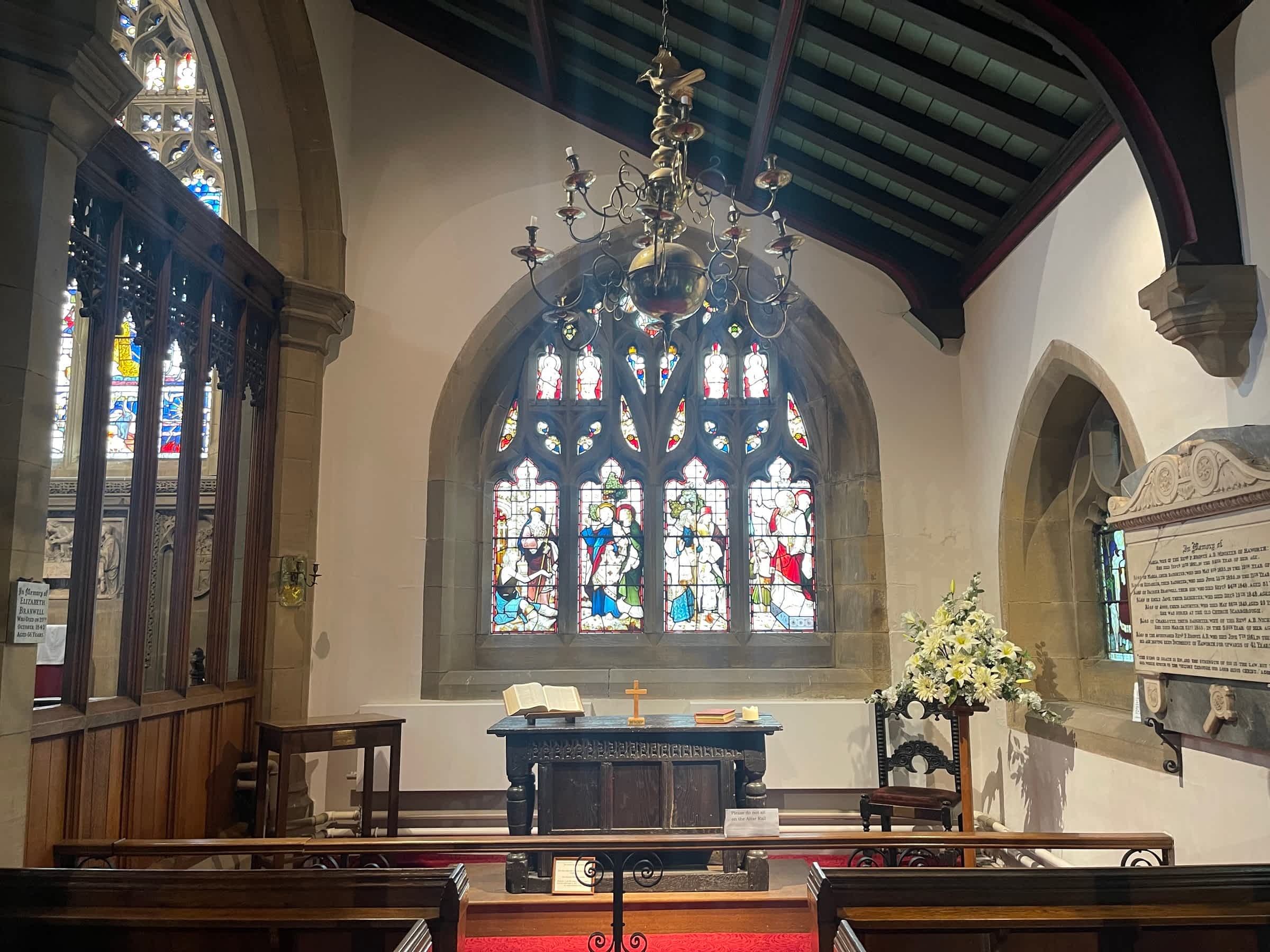
20/06/1855
Patrick Brontë made his own will.
23/07/1855
Elizabeth Gaskell visited Haworth to meet Patrick Brontë to discuss the biography of Charlotte Brontë.
13/08/1855
John Brown was buried in the churchyard. Arthur Nicholls officiated, and Patrick Brontë sat with Mrs. Mary Brown and Martha Brown in the Brontë pew.
02/10/1856
Elizabeth Gaskell wrote of Charlotte Brontë: "Leaving all authorship on one side, her character as a woman was unusual to the point of being unique. I never heard or read of anyone who was for an instant, or in any respect, to be compared to her. And everything she did and every word she said and wrote bore the impress of this remarkable character."
07/02/1857
The manuscript of the "Life of Charlotte Brontë" by Elizabeth Gaskell was completed.
24/02/1857
Patrick Brontë carried out his last marriage service at Haworth Church.
25/03/1857
The "Life of Charlotte Brontë" by Elizabeth Gaskell was published.
06/06/1857
Charlotte Brontë's previously rejected novel "The Professor" was published.
21/08/1857
With regard to the statement that Mr Brontë, in his desire to bring up his children simply and heartily, refused to permit them to eat flesh meat, he asserts that Nancy Garr alleges that the children had meat daily, and as much food as they chose. The early article from which they were restrained was butter, but its absence was compensated for by what is known in Yorkshire as "spice-cake," a type of bread that is the staple food at Christmas for all meals but dinner.
"I did not know that I had an enemy in the world, much less one who would traduce me before my death. Everything in that book 'the biography of his daughter' which relates to my conduct to my family is either false or distorted. I never did commit such acts as are ascribed to me. I stated this in a letter which I sent to Mrs Gaskell, requesting her at the same time to cancel the false statements about me in the next edition of her book. To this I received no other answer than that Mrs Gaskell was unwell, and unable to write."
Extract printed in the Daily News England, Friday, August 21, 1857
30/10/1859
Patrick Brontë preached his last sermon from the pulpit of Haworth Church.
07/06/1861
Patrick Brontë died at Haworth. He was 84.
12/06/1861
Patrick Brontë was buried in the family vault at Haworth Church. He had died on 7th June, aged 84.
01/10/1861
The auction of Brontë household items took place in Haworth.
25/08/1864
Arthur Bell Nicholls married again.
12/11/1865
Elizabeth Gaskell, who wrote 'The Life of Charlotte Brontë', died.
16/11/1865
Elizabeth Gaskell, who wrote 'The Life of Charlotte Brontë', was buried at Brook Street Chapel in Knutsford. She had died on November 12th, 1865.
18/10/1879
Mr James Ackroyd put up for auction the wood taken from the demolished Brontë Church. The bulk of it did not fetch the price of even ordinary wood, and some of the best oak beams were reserved. Several pieces had been disposed of at fancy prices prior to the sale.
19/01/1880
Martha Brown, servant of the Brontës, died aged 52.
26/03/1886
Nancy Garrs died. In 1816, she was employed by Patrick Brontë to help raise his children. She is buried in an unmarked grave at Undercliffe Cemetery.
09/01/1890
Mme Heger died in Brussels. The family ran the Pensionnat Heger, a finishing school in Brussels that Charlotte and Emily Brontë had attended.
01/03/1893
Mary Taylor, a close friend of Charlotte Brontë, died.
16/12/1893
The Brontë Society was founded in Bradford. The first meeting took place in Bradford Town Hall on December 16th at 3 PM, attended by more than 50 people.
18/05/1895
The first Brontë Museum opened on the upper floor of the Yorkshire Penny Bank at Haworth. The building is now the Tourist Information Centre.
26/11/1897
Ellen Nussey, Charlotte Brontë's lifelong friend, died aged 80.
02/12/1906
Arthur Bell Nicholls, husband of Charlotte Brontë, died. He was 87.
02/02/1909
“Dr Wilson says the Rev. John Wade Mr Story’s predecessor told him that when the Church was rebuilt in 1880 all bodies were removed from the interior of the Church keeping that of Mr Charnock and those of the Brontë family. Rev P.B lies about the chancel steps and Charlotte Emily etc under the large pillar on the right. Vault covered with concrete for foundation of pillar.”
05/03/1914
The portrait of Charlotte, Emily and Anne Brontë, painted by Branwell Brontë, was exhibited for the first time at the National Portrait Gallery. It had been presumed lost. After Charlotte Brontë died, her husband Rev. Nichols took the picture to Ireland. In 1914 it was discovered folded in a cupboard; the creases are visible on the picture.

04/08/1928
The Parsonage at Haworth was officially handed over to the Brontë Society.
14/06/1929
Probably the only living school-fellow of the Brontë sisters, Mr John Rushworth, a retired cartwright of Denholme, Yorks will shortly enter his 96th year.
10/08/1929
"The manuscript of Charlotte Brontë’s "The Violet" was sold at Sotheby's on Monday for £250."
24/04/1939
James Roosevelt, the son of US President Franklin D. Roosevelt, visited the Parsonage.
19/05/1989
The Brontë bridge was destroyed by a flash flood. It was rebuilt in 1990.
23/07/1997
Ann Crier MP (Keighley 1997 - 2010) gave
a speech to the House of Commons about her concern over the condition of
Top Withens.

10/04/2013
Charlotte Brontë's "I've been wandering in the greenwoods," dated 14 December 1829, written when she was just 13 sold at auction for £92,450.
April 2024
The terraced house in Thornton, Bradford, in which the Brontë siblings were born becomes under
public ownership after a community group raise funds to secure it.












